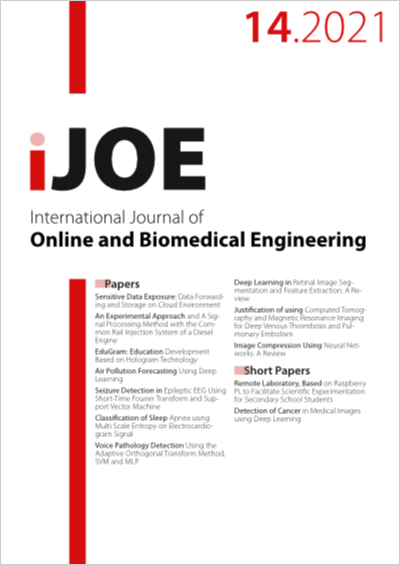Classification of Sleep Apnea using Multi Scale Entropy on Electrocardiogram Signal
DOI:
https://doi.org/10.3991/ijoe.v17i14.25905Keywords:
sleep apnea, electrocardiogram, multiscale entropy, support vector machineAbstract
One of sleep-disordered breathing (SDB) form is sleep apnea, commonly known as snoring during sleep, based on various complex mechanisms and predisposing factors. Sleep apnea is also related to various medical problems. It impacts morbidity and mortality so that it becomes a burden on public health services. Its detection needs to be done correctly through electrocardiogram signals to detect sleep apnea more quickly and precisely. This study was conducted to detect sleep apnea based on electrocardiogram signals using multi-scale entropy analysis. Multi-scale entropy (MSE) is used in a finite length of time series for measuring the complexity of the signal. MSE can be applied to both physical and physiological data sets and. In this paper we used MSE to detect Sleep Apnea on electrocardiogram (ECG) signals. MSE was applied two classes of ECG data, normal ECG signals, and apnea ECG signals. In this paper, classification and verification were carried out using the Support Vector Machine (SVM) and N-fold cross-validation (N-fold CV). From the experimental results, the highest accuracy was 85.6% using 5-fold CV and MSE scale of 10. The result shows that the system model that can detect sleep using the multi-scale entropy method
Downloads
Published
2021-12-14
How to Cite
Rizal, A., Iman, U. R., & Fauzi, H. (2021). Classification of Sleep Apnea using Multi Scale Entropy on Electrocardiogram Signal. International Journal of Online and Biomedical Engineering (iJOE), 17(14), pp. 79–89. https://doi.org/10.3991/ijoe.v17i14.25905
Issue
Section
Papers
License
Copyright (c) 2021 Achmad Rizal, Usman Rizki Iman, Hilman Fauzi

This work is licensed under a Creative Commons Attribution 4.0 International License.


